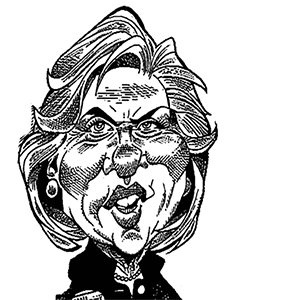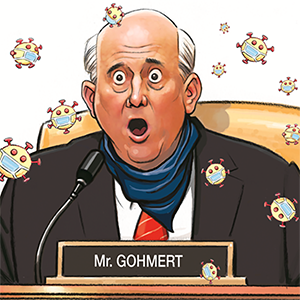Former Rep. William Lacy Clay Sr. dies at 94
Published in News & Features
WASHINGTON — Former Rep. William Lacy Clay Sr., a St. Louis powerbroker who became Missouri’s first elected Black member of Congress and went on to serve 16 terms in the House, died Wednesday at the age of 94.
First elected in 1968, the Democrat was succeeded in the House by his son, former Rep. William Lacy Clay Jr., who himself served for 10 terms. The elder Clay, born April 30, 1931, in St. Louis, was a fixture in his home town’s politics for more than six decades.
When he first came to Congress, Clay was labeled a Black militant. He gradually adjusted his political focus and rhetoric to match his slightly less Black and more conservative district, but his voting record remained decidedly liberal.
A founding member of the Congressional Black Caucus, Clay supported abortion rights and opposed amending the Constitution to permit laws to ban the burning of the flag. He voted against prohibiting the use of federal funds for needle distribution and against Republican proposals to permit states to use federal funds for school vouchers.
Over his 32-year tenure, Clay enjoyed some notable legislative successes, including the enactment in the first year of the Clinton administration of two measures he had long pushed for — the Family and Medical Leave Act and changes to the Hatch Act, which limits political activities of federal workers.
He suffered setbacks as well, especially once the Republicans gained the House majority in the 1994 midterm elections. If the Democrats had retained control of the chamber they’d held for 40 years, Clay would have become chairman of what was then known as the Education and Labor Committee, which he joined as a freshman in 1969. Instead, he became the ranking Democrat on the panel, known today as the Education and Workforce Committee.
Clay’s career thrived on confrontation. His own campaign literature once noted that he had been “arrested, convicted of contempt of court (and) served 110 days in jail” for demonstrating at a St. Louis bank.
While that incident took place years before his first election to the House in 1968, it was one of a string of such confrontations that earned him a reputation as a civil rights activist.
In 1954, while going through military training at Fort McClellan in Alabama, Clay found the post’s swimming pool and barber shop closed to Black soldiers and the noncommissioned officers’ club off-limits when white women were present. Clay led Blacks to swim in the pool, sit in at the barber shop and picket the club.
After returning to St. Louis, he became active in the NAACP and the Congress on Racial Equality, or CORE.
He was elected to the city’s Board of Aldermen in 1959 and became an official in the politically active Pipefitters Union in 1966. While keeping his identification as a civil rights militant, he moved closer over the years to the patronage politics of the local Democratic Party.
Redistricting by the Missouri Legislature in 1967 placed most of St. Louis’ 257,000 Black residents in the 1st District, ending years of fragmentation of the Black vote. Democrat Frank M. Karsten, the 1st District representative for 22 years, decided to retire rather than seek reelection in 1968.
With the backing of most local Black leaders, Clay emerged from a racially divided four-way primary with a 48% plurality. In the general election, he ran on a platform geared to the district’s 55% Black majority.
He called for more federal money for jobs, housing, health and education, and for changes in police agencies and the court systems to eliminate bias against Black people. Clay won 64% against Black Republican Curtis C. Crawford to become Missouri’s first Black congressman.
As Clay extended his tenure in the House, the population in the 1st District dwindled steadily.
The district lost one-quarter of its people during the 1970s, and redistricting in 1981 gave Clay nearly 200,000 new constituents, many of them blue-collar workers in largely white sections of St. Louis County.
In Clay’s old district, two-thirds of the population was Black; in the redrawn 1st, Black people barely formed a majority, and more whites than Blacks were registered to vote.
A sizable number of Clay’s new constituents fiercely objected to his support for abortion and for busing of students to integrate schools. In 1982, anti-Clay Democrats coalesced behind a white primary challenger, state Sen. Al Mueller, an opponent of abortion and busing. Mueller carried the St. Louis County portion of the 1st, but Clay, strongly backed by organized labor, crushed him in the city on his way to a 66% victory across the district.
Throughout his congressional career, Clay remained active in local politics. He clashed with former St. Louis Mayor Vincent C. Schoemehl Jr. In 1992, Clay worked for Schoemehl’s opponent in the Democratic gubernatorial primary, then-Lt. Gov. Mel Carnahan, who won that primary and went on to be elected governor.
Clay’s high profile in local politics at times put stress on his political organization, or what many called Clay’s “machine.”
In 1994, he drew three credible, if little-known, primary challengers, and although his nearest foe captured only 20% of the vote, Clay was renominated with just 53%.
In 1996, Clay crushed his solo primary opponent and won the general election with ease. In 1998, he had no primary opponent and easily won the general election with 73% of the vote. In 1999, he announced his retirement, paving the way for his son and namesake to win the seat in 2000.
©2025 CQ-Roll Call, Inc., All Rights Reserved. Visit cqrollcall.com. Distributed by Tribune Content Agency, LLC.






Comments